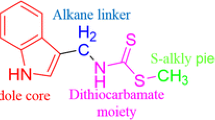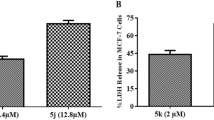Summary
In our previous study, we screened the anti-cancer properties of 10 benzothiazole derivatives in cervical cancer cell lines. In the present study, we aimed to delineate the mechanism of the apoptotic pathway (whether intrinsic or extrinsic) following the treatment of N-(4-(benzo[d]thiazol-2-yl)phenyl)-5-chloro-2-methoxybenzamide (named as A-07) on cervical cancer cell lines. Cellular stress by reactive oxygen species was measured using DCFDA dye by flowcytometry. Protein expression and localization was checked by immunofluorescence for γH2A.X, TP53, and CASP-3. Expression profiles of BAX and BCL-2 was done by semi-quantitative RT-PCR and PARP-1 (Poly(ADP-ribose) polymerase-1) by Western blot analysis. Bioinformatic studies were done using PDB websites, metaPocket 2.0 server, YASARA software and Discovery Studio 3.5 Visualizer. We demonstrate that the compound A-07 leads to ROS generation and double strand breaks in SiHa and C-33A cells. The induction of apoptosis in SiHa cells is associated with increased nuclear expression of the tumor suppressor protein, TP53. The shift in BAX/BCL-2 ratio, increased expression of Caspase-3 and cleaved Poly(ADP-ribose) polymerase-1 favour apoptotic signal in SiHa. In silico studies revealed that A-07 has inhibiting capabilities to the E6/E6AP/P53 complex. Our data suggest that treatment of A-07 causes p53 and caspase dependent apoptosis in HPV 16 infected SiHa cells.







Similar content being viewed by others
References
Doorbar J, Griffin H (2019) Refining our understanding of cervical neoplasia and its cellular origins. Papillomavirus Res 7:176–179. https://doi.org/10.1016/j.pvr.2019.04.005
Lin C, Franceschi S, Clifford GM (2018) Human papillomavirus types from infection to cancer in the anus, according to sex and HIV status: a systematic review and meta-analysis. Lancet Infect Dis 18(2):198–206. https://doi.org/10.1016/S1473-3099(17)30653-9
Vande Pol SB, Klingelhutz AJ (2013) Papillomavirus E6 oncoproteins. Virology 445(1–2):115–137. https://doi.org/10.1016/j.virol.2013.04.026
Bernard X, Robinson P, Nominé Y, Masson YM, Charbonnier S, Ramirez-Ramos JR, Deryckere F, Travé G, Orfanoudakis G (2011) Proteasomal degradation of p53 by human papillomavirus E6 oncoprotein relies on the structural integrity of p53 core domain. PLoS One 6(10). https://doi.org/10.1371/journal.pone.0025981
Wang SX, Zhang XS, Guan HS, Wang W (2014) Potential anti-HPV and related cancer agents from marine resources: an overview. Mar Drugs 12(4):2019–2035. https://doi.org/10.3390/md12042019
Tornesello ML, Annunziata C, Tornesello AL, Buonaguro L, Buonaguro FM (2018) Human Oncoviruses and p53 tumor suppressor pathway deregulation at the origin of human cancers. Cancers 10(7). https://doi.org/10.3390/cancers10070213
Ding B, Chi SG, Kim SH, Kang S, Cho JH, Kim DS, Cho NH (2007) Role of p53 in antioxidant defense of HPV-positive cervical carcinoma cells following H2O2 exposure. J Cell Sci 120(Pt 13):2284–2294
Yi JW, Jang M, Kim SJ, Kim SS, Rhee JE (2013) Degradation of p53 by natural variants of the E6 protein of human papillomavirus type 16. Oncol Rep 29(4):1617–1622. https://doi.org/10.3892/or.2013.2281
Synnott NC, Bauer MR, Madden S, Murray A, Klinger R, O'Donovan N, O'Connor D, Gallagher WM, Crown J, Fersht AR, Duffy MJ (2018) Mutant p53 as a therapeutic target for the treatment of triple-negative breast cancer: preclinical investigation with the anti-p53 drug, PK11007. Cancer Lett 414:99–106. https://doi.org/10.1016/j.canlet.2017.09.053
Butz K, Ristriani T, Hengstermann A, Denk C, Scheffner M, Hoppe-Seyler F (2003) siRNA targeting of the viral E6 oncogene efficiently kills human papillomavirus-positive cancer cells. Oncogene 22(38):5938–5945
Yamato K, Fen J, Kobuchi H, Nasu Y, Yamada T, Nishihara T, Ikeda Y, Kizaki M, Yoshinouchi M (2006) Induction of cell death in human papillomavirus 18-positive cervical cancer cells by E6 siRNA. Cancer Gene Ther 13(3):234–241
Butz K, Denk C, Ullmann A, Scheffner M, Hoppe-Seyler F (2000) Induction of apoptosis in human papillomavirus positive cancer cells by peptide aptamers targeting the viral E6 oncoprotein. Proc Natl Acad Sci 97(12):6693–6697
Martinez-Zapien D, Ruiz FX, Poirson J, Mitschler A, Ramirez J, Forster A, Cousido-Siah A, Masson M, Vande Pol S, Podjarny A, Travé G, Zanier K (2016) Structure of the E6/E6AP/p53 complex required for HPV-mediated degradation of p53. Nature 529(7587):541–545. https://doi.org/10.1038/nature16481
Khattak F, Haseeb M, Fazal S, Bhatti AI, Ullah M (2017) Mathematical modeling of E6-p53 interactions in cervical Cancer. Asian Pac J Cancer Prev 18(4):1057–1061
Hietanen S, Lain S, Krausz E, Blattner C, Lane DP (2000) Activation of p53 in cervical carcinoma cells by small molecules. Proc Natl Acad Sci 97(15):8501–8506
Hemann MT, Lowe SW (2006) The p53-Bcl-2 connection. Cell Death Differ 13(8):1256–1259
Pfeffer CM, Singh ATK (2018) Apoptosis: a target for anticancer therapy. Int J Mol Sci 19(2). https://doi.org/10.3390/ijms19020448
Kaufmann SH, Desnoyers S, Ottaviano Y, Davidson NE, Poirier GG (1993) Specific proteolytic cleavage of poly(ADP ribose) polymerase: an early marker of chemotherapy-induced apoptosis. Cancer Res 53(17):3976–3985
Toots M, Ustav M Jr, Männik A, Mumm K, Tämm K, Tamm T, Ustav E, Ustav M (2017) Identification of several high-risk HPV inhibitors and drug targets with a novel high-throughput screening assay. PLoS Pathog 13(2):e1006168. https://doi.org/10.1371/journal.ppat.1006168
Gill JG, Piskounova E, Morrison SJ (2016) Cancer, oxidative stress, and metastasis. Cold Spring Harb Symp Quant Biol 81:163–175. https://doi.org/10.1101/sqb.2016.81.030791
Kumari S, Badana AK, G MM, G S, Malla R (2018) Reactive oxygen species: a key constituent in Cancer survival. Biomark Insights 13:1–9. https://doi.org/10.1177/1177271918755391
Calaf GM, Urzua U, Termini L, Aguayo F (2018) Oxidative stress in female cancers. Oncotarget 9(34):23824–23842. https://doi.org/10.18632/oncotarget.25323
Salehi F, Behboudi H, Kavoosi G, Ardestani SK (2018) Oxidative DNA damage induced by ROS-modulating agents with the ability to target DNA: a comparison of the biological characteristics of citrus pectin and apple pectin. Sci Rep 8(1):13902. https://doi.org/10.1038/s41598-018-32308-2
Georgoulis A, Vorgias CE, Chrousos GP, Rogakou EP (2017) Genome instability and γH2AX. Int J Mol Sci 18(9). https://doi.org/10.3390/ijms18091979
Wang JY (2001) DNA damage and apoptosis. Cell Death Differ 8(11):1047–1048
Singh M, Singh SK (2014) Benzothiazoles: how relevant in cancer drug design strategy? Anti Cancer Agents Med Chem 14(1):127–146
Singh M, Modi A, Narayan G, Singh SK (2016) Benzothiazole derivatives bearing amide moiety: potential cytotoxic and apoptosis-inducing agents against cervical cancer. Anti-Cancer Drugs 27(6):519–532. https://doi.org/10.1097/CAD.0000000000000357
Uremis N, Uremis MM, Tolun FI, Ceylan M, Doganer A, Kurt AH (2017) Synthesis of 2-substituted Benzothiazole derivatives and their in vitro anticancer effects and antioxidant activities against pancreatic Cancer cells. Anticancer Res 37(11):6381–6389
Hegde M, Vartak SV, Kavitha CV, Ananda H, Prasanna DS, Gopalakrishnan V, Choudhary B, Rangappa KS, Raghavan SC (2017) A Benzothiazole derivative (5g) induces DNA damage and potent G2/M arrest in Cancer cells. Sci Rep 7(1):2533. https://doi.org/10.1038/s41598-017-02489-3
Li MH, Yang P, Yang T, Zhang K, Liu Y, Liu J, Li LM, Luo XY, Yang SX, Zou Q, Zhang CJ (2016) A novel water-soluble benzothiazole derivative BD926 triggers ROS-mediated B lymphoma cell apoptosis via mitochondrial and endoplasmicreticulum signaling pathways. Int J Oncol 49(5):2127–2134. https://doi.org/10.3892/ijo.2016.3684
Sedelnikova OA, Rogakou EP, Panyutin IG, Bonner WM (2002) Quantitative detection of (125)IdU-induced DNA double-strand breaks with gamma-H2AX antibody. Radiat Res 158(4):486–492
Dull AB, Wilsker D, Hollingshead M, Mazcko C, Annunziata CM, LeBlanc AK, Doroshow JH, Kinders RJ, Parchment RE (2018) Development of a quantitative pharmacodynamic assay for apoptosis in fixed tumor tissue and its application in distinguishing cytotoxic drug-induced DNA double strand breaks from DNA double strand breaks associated with apoptosis. Oncotarget 9(24):17104–17116. https://doi.org/10.18632/oncotarget.24936
Xuejiao S, Yong X, Ningyu W, Lidan Z, Xuanhong S, Youzhi X, Tinghong Y, Yaojie S, Yongxia Z, Luoting Y (2013) A novel benzothiazole derivative YLT322 induces apoptosis via the mitochondrial apoptosis pathway in vitro with anti-tumor activity in solid malignancies. PLoS One 8(5):e63900. https://doi.org/10.1371/journal.pone.0063900
Kok SH, Gambari R, Chui CH, Yuen MC, Lin E, Wong RS, Lau FY, Cheng GY, Lam WS, Chan SH, Lam KH, Cheng CH, Lai PB, Yu MW, Cheung F, Tang JC, Chan AS (2008) Synthesis and anti-cancer activity of benzothiazole containing phthalimide on human carcinoma cell lines. Bioorg Med Chem 16(7):3626–3631. https://doi.org/10.1016/j.bmc.2008.02.005
Ramuz O, Isnardon D, Devilard E, Charafe-Jauffret E, Hassoun J, Birg F, Xerri L (2003) Constitutive nuclear localization and initial cytoplasmic apoptotic activation of endogenous caspase-3 evidenced by confocal microscopy. Int J Exp Pathol 84(2):75–81
Prokhorova EA, Kopeina GS, Lavrik IN, Zhivotovsky B (2018) Apoptosis regulation by subcellular relocation of caspases. Sci Rep 8(1):12199. https://doi.org/10.1038/s41598-018-30652-x
Chaitanya GV, Steven AJ, Babu PP (2010) PARP-1 cleavage fragments: signatures of cell-death proteases in neurodegeneration. Cell Commun Signal 8:31. https://doi.org/10.1186/1478-811X-8-31
Prasad CB, Prasad SB, Yadav SS, Pandey LK, Singh S, Pradhan S, Narayan G (2017) Olaparib modulates DNA repair efficiency, sensitizes cervical cancer cells to cisplatin and exhibits anti-metastatic property. Sci Rep 7(1):12876. https://doi.org/10.1038/s41598-017-13232-3
Hastak K, Bhutra S, Parry R, Ford JM (2017) Poly (ADP-ribose) polymerase inhibitor, an effective radiosensitizer in lung and pancreatic cancers. Oncotarget 8(16):26344–26355. https://doi.org/10.18632/oncotarget.15464
Pushpavalli S, Ramaiah MJ, Srinivas C, Mukhopadhya D, Aditya JL, Kumbhare RM, Bhadra U, Bhadra MP (2011) Effect of Benzothiazole based conjugates in causing apoptosis by regulating p53, PTEN and MAP kinase proteins affecting miR-195a and miR-101-1. Cancer Cell Int 11:36. https://doi.org/10.1186/1475-2867-11-36
Vince JE, De Nardo D, Gao W, Vince AJ, Hall C, McArthur K, Simpson D, Vijayaraj S, Lindqvist LM, Bouillet P, Rizzacasa MA, Man SM, Silke J, Masters SL, Lessene G, Huang DCS, Gray DHD, Kile BT, Shao F, Lawlor KE (2018) The mitochondrial apoptotic effectors BAX/BAK activate Caspase-3 and -7 to trigger NLRP3 Inflammasome and Caspase-8 driven IL-1β activation. Cell Rep 25(9):2339–2353. https://doi.org/10.1016/j.celrep.2018.10.103
Fischer M (2017) Census and evaluation of p53 target genes. Oncogene 36(28):3943–3956. https://doi.org/10.1038/onc.2016.502
Vaseva AV, Moll UM (2009) The mitochondrial p53 pathway. Biochim Biophys Acta 1787(5):414–420. https://doi.org/10.1016/j.bbabio.2008.10.005
Ozaki T, Nakagawara A (2011) Role of p53 in cell death and human cancers. Cancers (Basel) 3(1):994–1013. https://doi.org/10.3390/cancers3010994
Zhou Y, Wei Y, Zhu J, Wang Q, Bao L, Ma Y, Chen Y, Feng D, Zhang A, Sun J, Nallar SC, Shen K, Kalvakolanu DV, Xiao W, Ling B (2011) GRIM-19 disrupts E6/E6AP complex to rescue p53 and induce apoptosis in cervical cancers. PLoS One 6(7):e22065. https://doi.org/10.1371/journal.pone.0022065
Haupt S, Berger M, Goldberg Z (2003) Haupt Y (2003) apoptosis - the p53 network. J Cell Sci 116(Pt 20):4077–4085
Saha B, Adhikary A, Ray P, Saha S, Chakraborty S, Mohanty S, Das K, Mukherjee S, Mazumdar M, Lahiri L, Hossain DM, Sa G, Das T (2012) Restoration of tumor suppressor p53 by differentially regulating pro- and anti-p53 networks in HPV-18-infected cervical cancer cells. Oncogene 31(2):173–186. https://doi.org/10.1038/onc.2011.234
Guedes IA, de Magalhães CS, Dardenne LE (2014) Receptor-ligand molecular docking. Biophys Rev 6(1):75–87. https://doi.org/10.1007/s12551-013-0130-2
Shaikh F, Sanehi P, Rawal R (2012) Molecular screening of compounds to the predicted Protein-Protein Interaction site of Rb1-E7 with p53- E6 in HPV. Bioinformation 8(13):607–612. https://doi.org/10.6026/97320630008607
Acknowledgements
University Grants Commission, New Delhi and Banaras Hindu University DST-PURSE programme for Junior and Senior Research fellowships to AM; Banaras Hindu University UGC-UPE and Banaras Hindu University DST-PURSE programmes for research partial funding to GN and SS; Department of Biotechnology, Banaras Hindu University and Interdisciplinary School of Life Sciences, Banaras Hindu University for equipment facilities.
Funding
The work was supported by University Grants Commission, New Delhi and Banaras Hindu University DST-PURSE programme for Junior and Senior Research fellowships to AM; Banaras Hindu University UGC-UPE and Banaras Hindu University DST-PURSE programmes for research funding to GN and SS.
Author information
Authors and Affiliations
Corresponding author
Ethics declarations
Conflict of interest
The authors declare that there is no conflict of interest.
Ethical approval
This article does not contain any studies with human participants or animals performed by any of the authors.
Additional information
Publisher’s note
Springer Nature remains neutral with regard to jurisdictional claims in published maps and institutional affiliations.
Rights and permissions
About this article
Cite this article
Modi, A., Singh, M., Gutti, G. et al. Benzothiazole derivative bearing amide moiety induces p53-mediated apoptosis in HPV16 positive cervical cancer cells. Invest New Drugs 38, 934–945 (2020). https://doi.org/10.1007/s10637-019-00848-7
Received:
Accepted:
Published:
Issue Date:
DOI: https://doi.org/10.1007/s10637-019-00848-7




